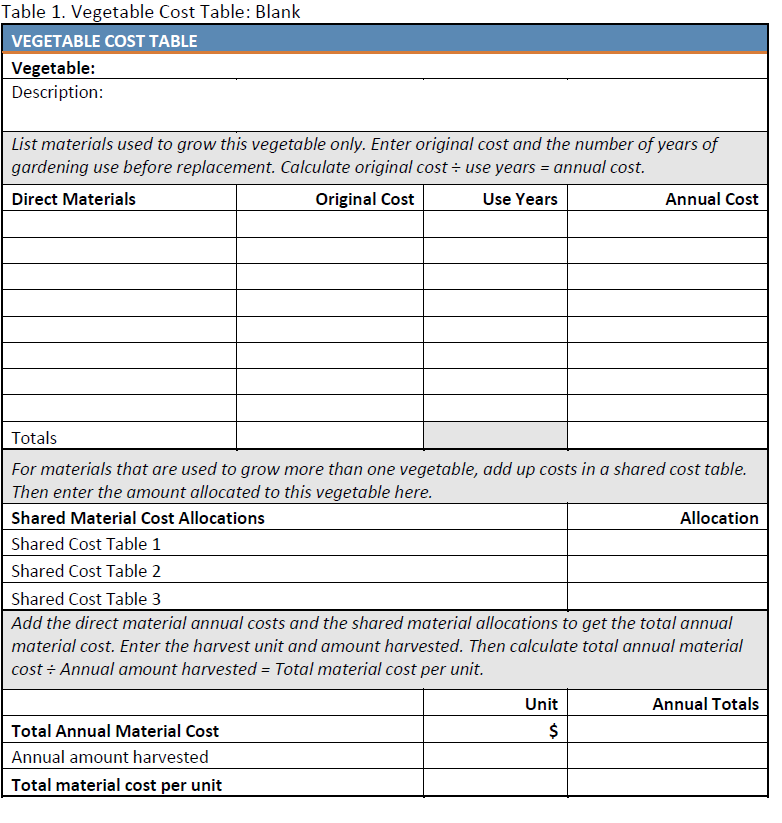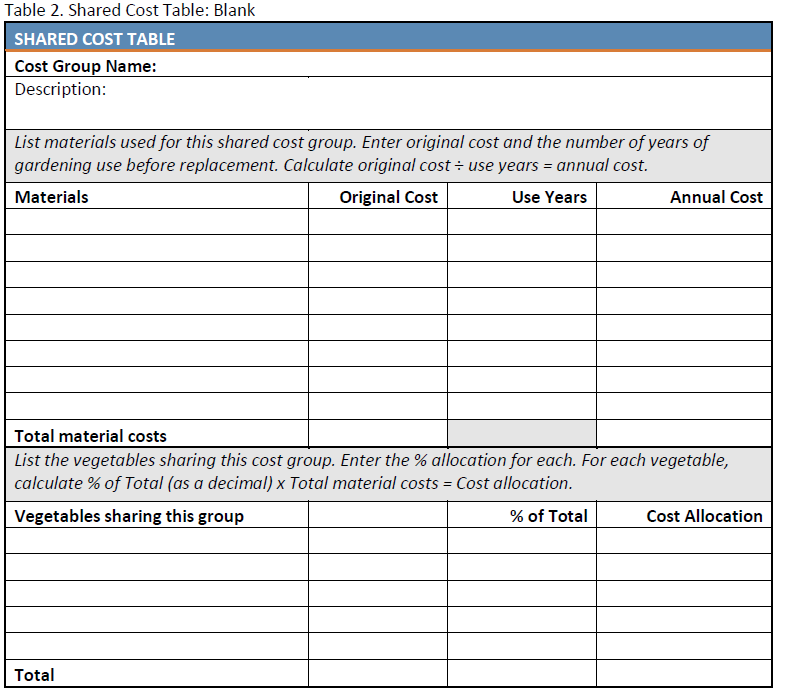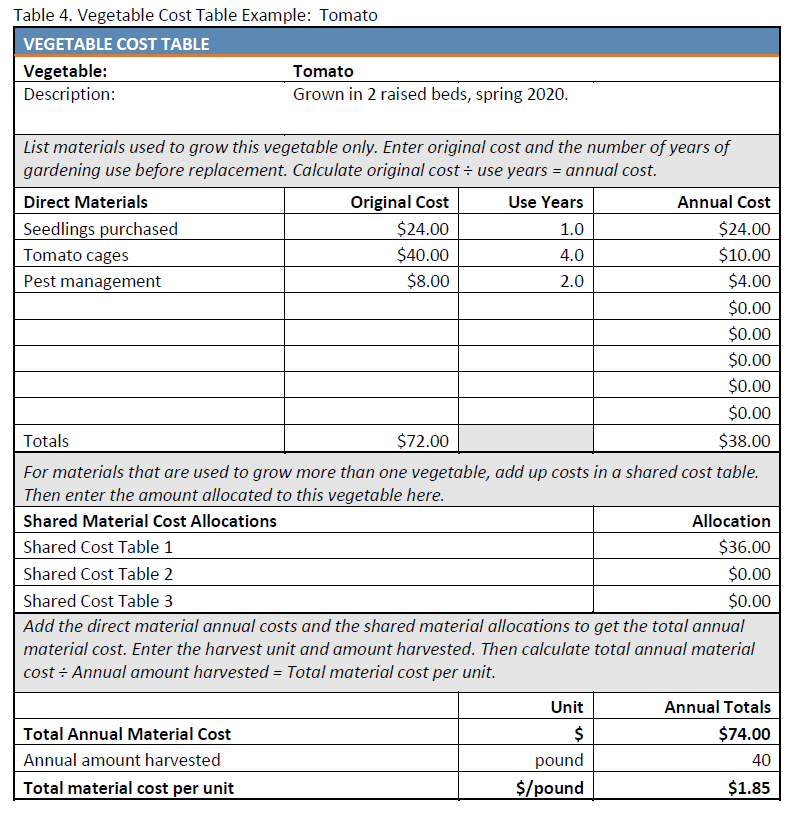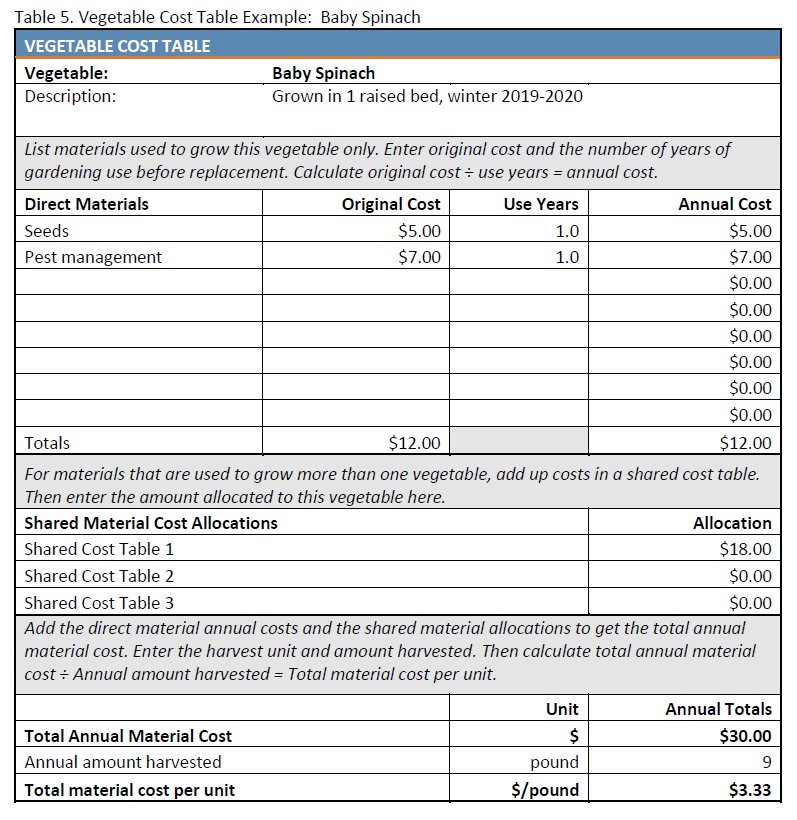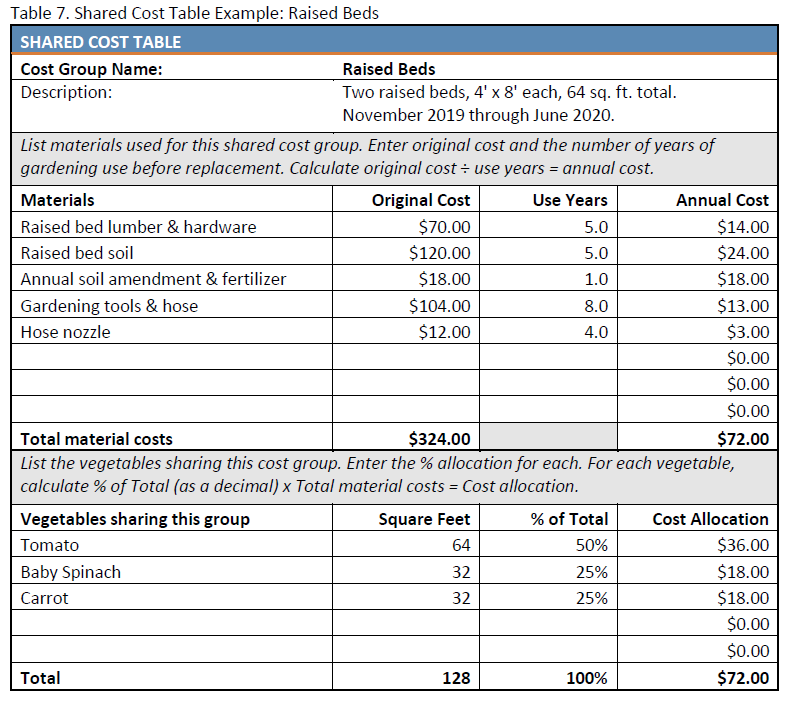White Paper: Costs and Benefits of Vegetable Gardening
Introduction
One-third of all U.S. households participate in food gardening (NGA 2014). Vegetable gardening is the most common type of food gardening (NGA 2014). In 2020, the COVID-19 pandemic generated a surge of interest in vegetable gardening with people confined at home and trying to be more self-sufficient (Yu 2020).
Benefits of gardening are numerous, and motivations vary. One motivating factor for many gardeners is to save money on their food bill. Other gardeners are motivated primarily by nonfinancial aspects of gardening. In either case it is helpful to consider the cost of gardening relative to the benefits.
The cost of purchasing food (e.g., $2.00 per pound of tomatoes) or a gym membership (e.g., $50 per month) is straight forward. Estimating the costs of gardening is not as simple. Does it cost you $1.00 per pound or $10.00 per pound to grow tomatoes in your garden? How do you know? This publication serves as a guide to estimating the costs of vegetable gardening. But first, we describe some benefits of gardening.
Benefits of Vegetable Gardening
Vegetable gardening can provide many benefits for the gardener and the household. Some benefits are subjective. For example, people may garden because they enjoy it or perceive better taste from fresh, homegrown produce (NGA 2014).
Other benefits have been determined through scientific research. For example, fresh vegetables gradually lose nutrients after harvest (Barrett). A vegetable harvested from your garden and eaten the same day will have higher nutritional content than an identical vegetable that has spent several days or weeks sitting in storage, transport, and store displays. Numerous studies have documented the positive effects of gardening on physical and mental health (Soga et al. 2017). Some studies have found that when kids participate in gardening, they are more likely to eat vegetables (Saint Louis University 2007 and Moore 2018).
Gardening also can provide financial benefits. If you can grow vegetables for less money than it would cost to buy the same vegetables at the grocery store, you gain a financial benefit (cost savings). Langellotto (2014) reviewed several studies of gardening costs and yields. She found that in most cases the value of food produced was greater than the cost, especially when no labor cost was counted. But gardening does require a financial investment, even if a modest one, and there are no guarantees that your savings on grocery expenses will outweigh your gardening costs.
Knowing your cost savings from growing different vegetables can help you choose the most economical crops and assess whether you are getting a financial benefit from gardening. The next section describes how you can estimate your costs and cost savings from your vegetable garden.
Estimating Costs and Savings from Vegetable Gardening
We suggest a framework to help you estimate your costs and cost savings from vegetable gardening. We assume you do not pay someone to garden for you, but your own labor is an important input too. Any “cost” you assign to your own time and effort is subjective. You may think of the cost savings or other benefits of gardening as the “return” for your labor. You decide whether those benefits are worth the time you spend on gardening.
Our focus is on estimating the costs of materials, including gardening supplies and tools. A common mistake is to leave some costs out, which makes a cost estimate lower than the actual cost. It is important to think about all the materials that go into your vegetable garden.
Your cost savings (or extra cost) depend on three factors: your gardening costs, the size of your harvest, and the price you would have paid for vegetables if not grown in your garden. To know your cost and cost savings from gardening you will have to keep records of your gardening expenditures and the amount you harvest. A kitchen scale can be used to weigh the amount of each vegetable you harvest.
You can use the blank Vegetable Cost Table (Table 1) to calculate costs for a single vegetable. Start by listing all the materials you use to grow this vegetable only. Materials that are shared by multiple vegetables will be listed separately in a Shared Cost Table (Table 2). Once you have listed all your gardening materials, including any garden supplies and tools, enter the original cost (the amount you paid) for each item. Some of the materials will last for more than one year. In the Use Years column, estimate the number of years you will use each item for gardening before it is replaced. Then calculate the annual cost for each item, which is the original cost divided by the use years.
Table 4 shows an example Vegetable Cost Table for tomatoes. Direct materials (used only by tomatoes) include the tomato seedlings, tomato cages, and pest management material. Tomato cages are purchased for $40, and we expect the cages to be used for 4 years before being replaced. Therefore, the annual cost of the tomato cages is $10 ($40 ÷ 4). It is not appropriate to assign the entire cost of the cages to your first year’s tomatoes, and no cost to the tomatoes in following years. Instead, we spread out the cost of the cages over the tomato crops that use the cages. Each year’s tomato harvest is assigned a portion of the original cost.
What if some of your materials are shared by multiple vegetables? Put those shared items into costs groups. Each group should contain items shared by the same vegetables. For example, our raised beds are shared by tomatoes, baby spinach, and carrots. Our hydroponic system costs are shared by butterhead lettuce and mini romaine. We put the raised bed materials into one cost group and the hydroponic system materials into a separate cost group.
You can use the blank Shared Cost Table (Table 2) to list shared materials for one cost group. Enter the original cost and use years for each item, just as you did for Table 1. Calculate the annual cost for each item by dividing the original cost by the use years. At the bottom of the Shared Cost Table, list the vegetables sharing that cost group. For each vegetable enter a percentage of the total group costs that should be allocated to that vegetable. A percentage based on square feet occupied by each vegetable could be a reasonable way to allocate shared costs. Calculate the dollar amount allocated to each vegetable by multiplying the percentage (as a decimal) times the total annual cost for the group. Your percent allocations for all the vegetables sharing the group should sum to 100%. The dollar amount allocated to all the vegetables should sum to the total annual cost for the group.
Table 7 shows an example Shared Cost Table for two raised beds. In our example, baby spinach is grown in one, and carrots are grown in the other during the winter. In the spring, tomatoes are grown in both raised beds. Based on the number of beds occupied (or square feet), we assign 50% of the raised bed costs to tomato, 25% to baby spinach, and 25% to carrot.
In the Vegetable Cost Table (Table 1), you can sum the annual costs of the direct materials (materials used only for that vegetable). Then enter any shared cost allocations from Shared Cost Tables. Sum the annual direct cost plus the shared allocation(s) to get the total annual material cost for that vegetable. Then at the bottom of Table 1, enter the harvest unit (e.g., pounds) and the annual amount harvested. Calculate the total material cost per unit by dividing the total annual material cost by the amount harvested. The total material cost per unit is what you can compare to the price you would have paid for the vegetable at the grocery store.
Tables 4, 5, and 6 show examples for tomatoes, baby spinach, and carrots. Those three vegetables are grown in raised beds. Our estimates for material cost per unit are $1.85/lb for tomatoes, $3.33/lb for baby spinach, and $2.00/lb for carrots.
You can use the blank Cost Savings Table (Table 3) to compare your garden vegetable costs per unit to the price of similar vegetables at the grocery store. Your cost savings per unit is the grocery store cost per unit (price) minus the garden cost per unit. In the example shown in Table 8, we save $0.14 per pound of tomatoes and $4.67 per pound of baby spinach grown in the garden. But carrots cost us $0.50/lb more from the garden than from the grocery store.
There may be other benefits to growing carrots in a home garden, but in this example cost savings is not one of them. Every gardener needs to decide whether the benefits outweigh any added cost, or whether the cost savings and other benefits are worth the time spent gardening.
We hope this document helps you estimate the costs for your garden, so that you know whether it costs you $1.00 per pound or $10.00 per pound to grow tomatoes. If you would rather do cost estimates on a computer and let it do the math for you, an interactive Excel workbook is available, along with an example PDF.
Interactive Workbook & Tutorial
Conclusions
Vegetable gardening is an activity with many benefits, but also some costs. Knowing your costs will enable you to compare the benefits with the costs. Accurately estimating your cost per unit harvested will allow you to calculate the financial benefit (cost savings) from growing different vegetables.
Authors
The authors and contributors to this UF/IFAS Extension document include Kevin Athearn, Hanna Wooten, Liz Felter, Catherine Campbell, Jessica Ryals, Lorna Bravo, Juanita Popenoe, Wendy Wilber, Matt Lollar, LuAnn Duncan, Christa Court, Debora Bell, and Saqib Mukhtar.
References
Barrett, D.M. 2007. Maximizing the nutritional value of fruits & vegetables. University of California, Davis. Available at https://postharvest.ucdavis.edu/publication/maximizing-nutritional-value-fruits-vegetables.
Langellotto, G.A. 2014. What are the economic costs and benefits of home vegetable gardens? Journal of Extension 52,2. Available at “What Are the Economic Costs and Benefits of Home Vegetable Gardens?” by Gail Ann Langellotto (clemson.edu).
Moore, M. 2018. Kids in the garden: nutritious and fun. Academy of Nutrition and Dietetics. Available at https://www.eatright.org/food/nutrition/eating-as-a-family/kids-in-the-garden-nutritious-and-fun.
National Gardening Association (NGA). 2014. Garden to table: a 5-year look at food gardening in America. Available at https://garden.org/special/pdf/2014-NGA-Garden-to-Table.pdf.
Saint Louis University. 2007. Children eat more fruits and vegetables if they are homegrown. ScienceDaily. Available at https://www.sciencedaily.com/releases/2007/04/070418163652.htm.
Soga, M., K.J. Gaston, and Y. Yamaura. 2017. Gardening is beneficial for health: a meta-analysis. Preventive Medicine Reports 5, 92-99. Available at https://www.sciencedirect.com/science/article/pii/S2211335516301401.
Yu, A. 2020. Emptier grocery shelves help cultivate a growing interest in home gardening. WHYY.org. https://whyy.org/articles/emptier-grocery-shelves-help-cultivate-a-growing-interest-in-home-gardening/
Tables
